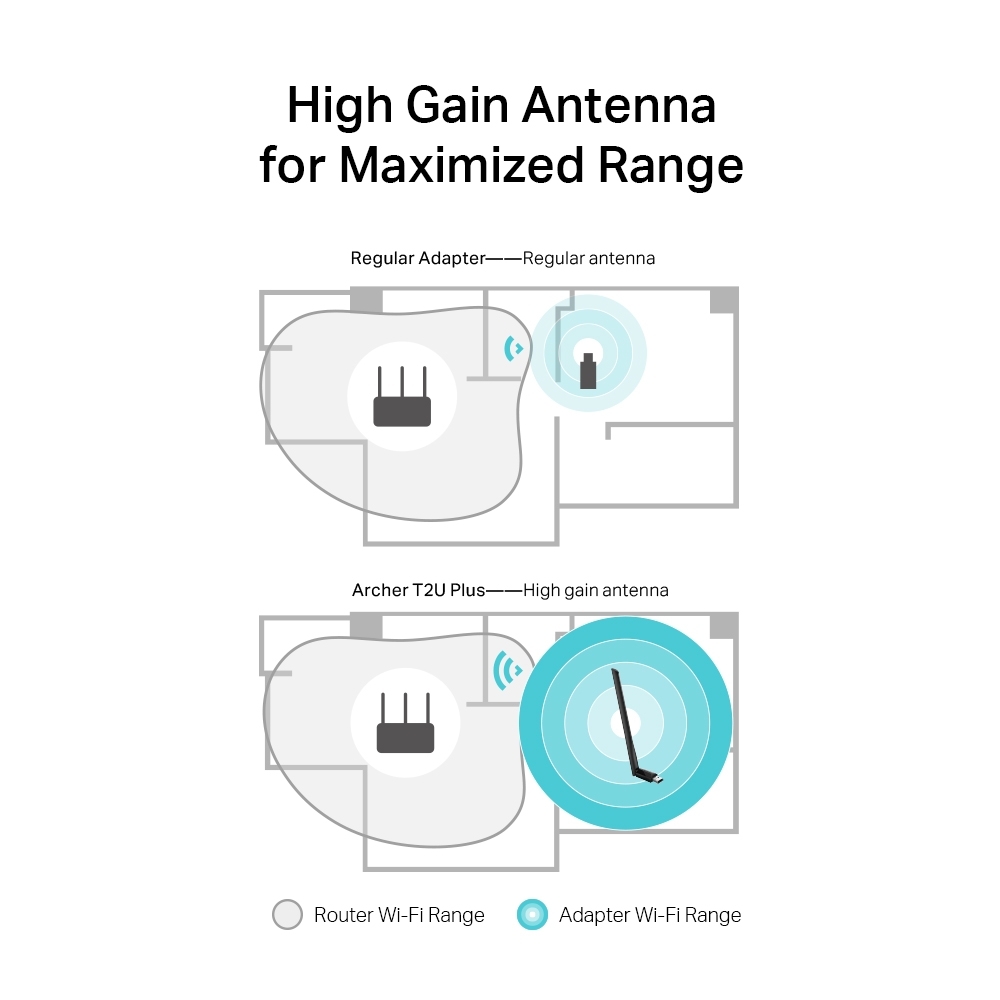Archer T2U Plus
Adaptador USB Wireless Dual Band AC600 de alto ganho
- Wi-Fi de alta velocidade: o suporte 256QAM aumenta a velocidade de transmissão de dados de 2,4 GHz de 150 Mbps para 200 Mbps, 200 Mbps na banda de 2,4 GHz e 433 Mbps na banda de 5 GHz, para que possa desfrutar plenamente de uma ligação Wi-Fi AC rápida.
- Sem fios de banda dupla: as bandas de 2,4 GHz e 5 GHz proporcionam uma conetividade flexível, dando aos seus dispositivos acesso ao mais recente router Wi-Fi de banda dupla para uma velocidade mais rápida e um alcance alargado
- Antena de alto ganho: Uma antena de alto ganho de 5dBi melhora consideravelmente a receção e a força do sinal de transmissão do adaptador USB
- Suporta os sistemas operativos mais recentes: Totalmente compatível com Windows 11/10/8.1/8/7/XP, Mac OS 10.15 e anteriores
Alto ganho, alto desempenho
Maior alcance para uma experiência online sem problemas
Adaptador USB de banda dupla sem fios AC600 de alto ganho
T2U Plus
Adaptador de banda dupla de alta velocidade para melhores ligações
O Archer T2U Plus recebe sinais Wi-Fi em duas bandas separadas. O suporte 256QAM aumenta a taxa de dados de 2,4 GHz de 150 Mbps para 200 Mbps, proporcionando um desempenho 33% mais rápido. As velocidades de 200 Mbps na banda de 2,4 GHz são perfeitas para uma utilização normal, como navegar na Web com dispositivos antigos. As velocidades de 433 Mbps na banda de 5 GHz são ideais para transmissão em HD e jogos online sem atrasos.
-
-
433Mbps em 5GHz
-
200Mbps em 2.4GHz
- Com 256QAM
- 200 Mbps
- Sem 256QAM
- 150 Mbps
Aumento do alcance
O Archer T2U Plus tem uma antena externa de alto ganho de 5dBi para garantir uma transmissão e receção de sinal mais fortes. Desfrute de uma ligação Wi-Fi estável em toda a sua casa.
 Adaptador regular--Antena regular T2U Plus--Antena de alto ganho
Adaptador regular--Antena regular T2U Plus--Antena de alto ganho - Alcance do router Wi-Fi
- Alcance do adaptador Wi-Fi

Antena de alto ganho de 5dBi
Antena ajustável e multidirecional
Rode e ajuste a antena em várias direcções para melhorar a experiência de utilização e o desempenho em diferentes ambientes.
 180°
180° 90°
90°
Configuração fácil
Uma interface de utilizador amigável garante uma instalação simples.

Segurança avançada
As normas de encriptação WPA/WPA2 mantêm a sua ligação sem fios protegida contra intrusos.

Sistema operativo
Suporta sistemas operativos como o Windows 11/10/8.1/8/7/XP, Mac OS 10.15 e anteriores
| CARACTERÍSTICAS DE HARDWARE | |
|---|---|
| Interface | USB 2.0 |
| LED | Status |
| Dimensões (L x P x A) | 57.8 × 18 × 173.4 mm |
| Antena | 5dBi |
| FUNCIONALIDADES WI-FI | |
|---|---|
| Normas Wireless | IEEE 802.11b/g/n 2.4 GHz, IEEE 802.11a/n/ac 5 GHz |
| Wireless Speeds | 600 Mbps (200 Mbps on 2.4 GHz, 433 Mbps on 5 GHz) |
| Frequências | 2.4 GHz, 5 GHz |
| Modos Wireless | Ad-Hoc / Infrastructure Mode |
| Segurança Wireless | WEP, WPA/WPA2, WPA-PSK/WPA2-PSK |
| Tecnologia de Modulação | DBPSK, DQPSK, CCK, OFDM, 16-QAM, 64-QAM, 256-QAM |
| OUTROS | |
|---|---|
| Certificações | FCC, CE, RoHS |
| Conteúdo da embalagem | AC600 High Gain Wireless Dual Band USB Adapter Archer T2U PlusQuick Installation GuideResource CD |
| Requisitos de Sistema | Windows11/10/8.1/8/7/XP, Mac OS 10.15 and earlier |
| Temperatura e Humidade | Operating Temperature: 0°C~40°C (32°F ~104°F)Storage Temperature: -40°C~70°C (-40°F ~158°F)Operating Humidity: 10%~90% non-condensingStorage Humidity: 5%~90% non-condensing |
† As taxas máximas de sinal sem fios são as taxas físicas derivadas das especificações da norma IEEE 802.11. O alcance, a cobertura e o número máximo de dispositivos ligados baseiam-se em resultados de testes em condições normais de utilização. O rendimento real dos dados sem fios, a cobertura sem fios e o número de dispositivos ligados não são garantidos e variam em resultado de 1) factores ambientais, incluindo materiais de construção, objectos físicos e obstáculos, 2) condições de rede, incluindo interferências locais, volume e densidade de tráfego, localização do produto, complexidade da rede e sobrecarga da rede, e 3) limitações do AP, incluindo desempenho nominal, localização, qualidade da ligação e estado do AP.
A velocidade real da rede pode ser limitada pela taxa da porta Ethernet WAN ou LAN do produto, a taxa suportada pelo cabo de rede, factores do fornecedor de serviços de Internet e outras condições ambientais.













